Energy Efficiency
14 Essential Tips for Heat Pump Efficiency in Eco-Homes

We have 14 crucial tips to boost the efficiency of your heat pump in eco-friendly homes.
Did you know that heating and cooling account for up to 50% of energy usage in a typical home? That’s why it’s crucial to optimize your heat pump performance.
From choosing the right size unit to weatherproofing your home, we’ll show you how to maximize efficiency and reduce energy costs.
Get ready to master the art of heat pump efficiency and create a more sustainable home.
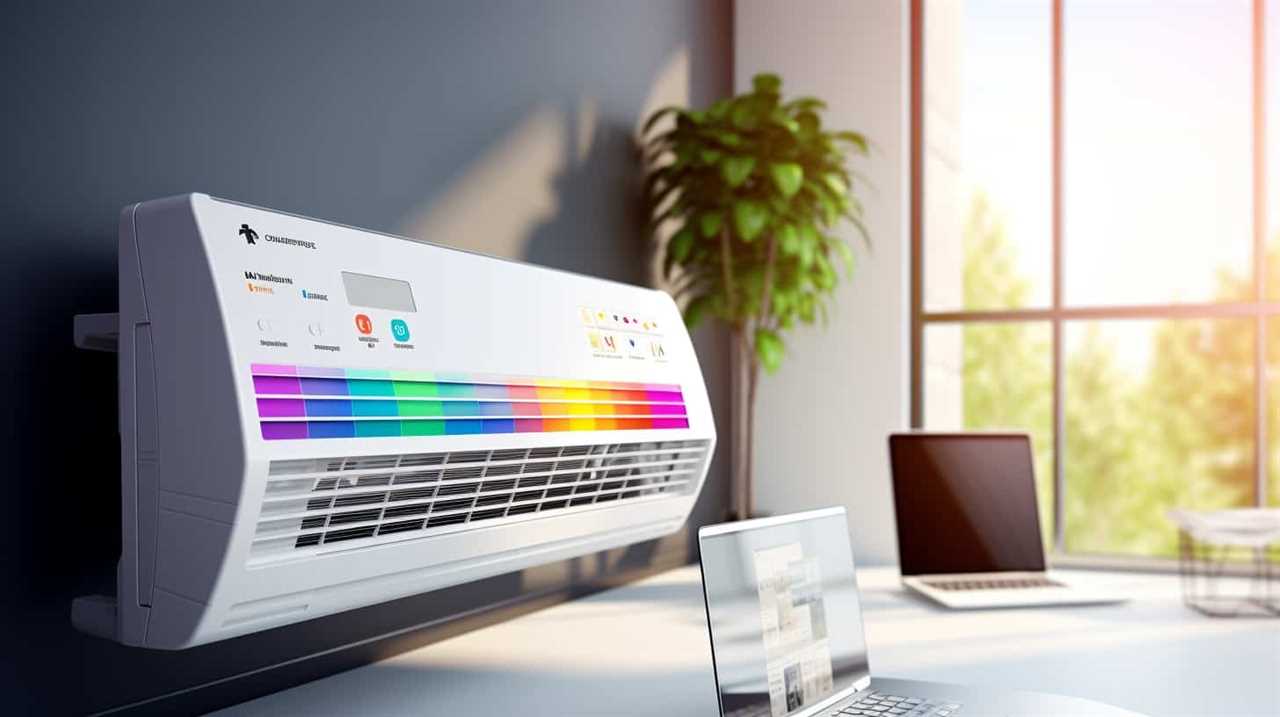
Key Takeaways
- Proper sizing of the heat pump is essential for optimal efficiency.
- Regular maintenance improves efficiency and prolongs the heat pump’s lifespan.
- Use energy monitoring tools to track energy consumption and identify areas for improvement.
- Insulation plays a crucial role in maximizing heat pump performance and reducing energy consumption.
Understanding Heat Pump Efficiency
To maximize the efficiency of our heat pump, we need to understand how it works. Heat pump performance directly impacts energy consumption, making it crucial to grasp the inner workings of this system.
A heat pump operates by transferring heat from one location to another using a refrigerant. It functions on the principle of extracting heat from a cold space and pumping it into a warmer space. This process requires a small amount of energy to operate the pump and compressor.
The efficiency of a heat pump is measured by its coefficient of performance (COP), which compares the amount of heat produced to the energy consumed. A higher COP signifies better efficiency and lower energy consumption, resulting in cost savings and reduced environmental impact.
Choosing the Right Size Heat Pump for Your Eco-Home
We should consider the square footage and insulation of our eco-home when choosing the right size heat pump. Heat pump sizing considerations are crucial for ensuring optimal performance and energy efficiency.
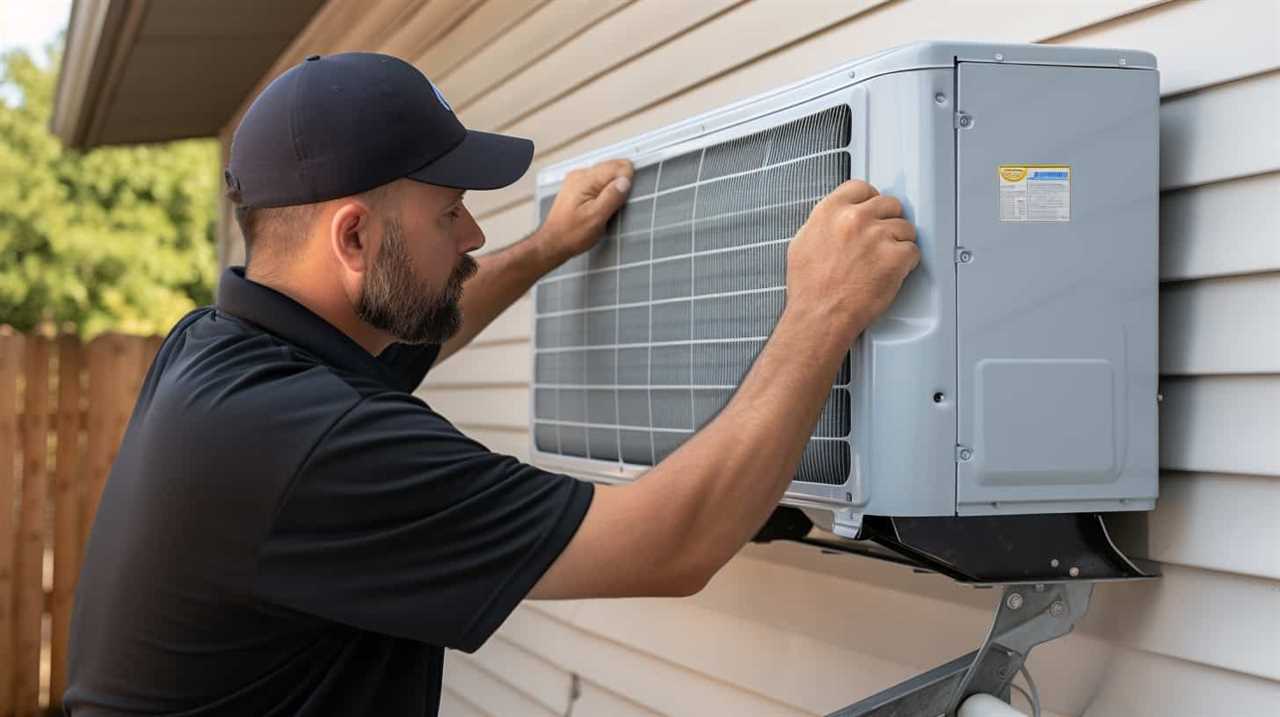
An undersized heat pump may struggle to adequately heat or cool our home, leading to discomfort and increased energy consumption. On the other hand, an oversized heat pump may cycle on and off frequently, resulting in inefficient operation and unnecessary wear and tear.
To determine the appropriate size, we need to calculate the heating and cooling loads based on factors such as square footage, insulation levels, and climate. Consulting with a professional HVAC technician is recommended to accurately assess our eco home heat pump requirements.
Proper Heat Pump Installation Techniques
When it comes to proper heat pump installation techniques, there are a few key points to keep in mind.
-
First, optimal placement is crucial for maximizing efficiency. This means ensuring that the heat pump is installed in a location that allows for proper airflow and minimal obstructions.

-
Second, correct ductwork installation is essential for proper air distribution throughout the home.
-
Finally, regular maintenance is important to keep the heat pump running smoothly and efficiently.
Optimal Placement for Efficiency
The optimal placement for efficiency in heat pump installation is crucial for maximizing its performance in eco-homes. When determining the optimal positioning for your heat pump, consider the following landscaping considerations:
-
Location: Place the heat pump in a shaded area to prevent it from being exposed to direct sunlight, which can decrease its efficiency.
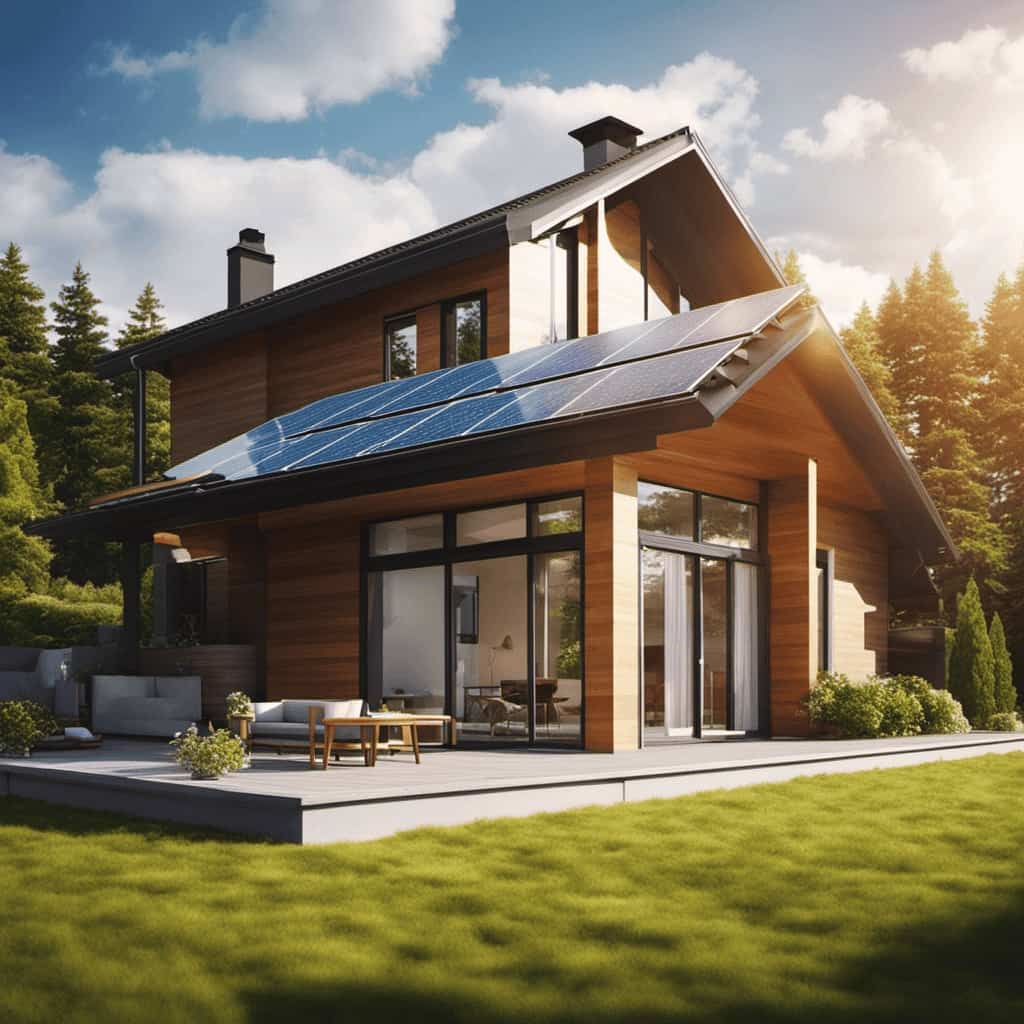
-
Airflow: Ensure that there’s ample space around the heat pump for proper airflow. Avoid placing it near obstructions that could restrict airflow, such as tall bushes or fences.
-
Noise reduction: If noise is a concern, consider placing the heat pump away from living areas or bedrooms to minimize any potential disturbance.
-
Accessibility: Install the heat pump in a location that allows easy access for maintenance and repairs.
By taking these factors into account, you can optimize the efficiency of your heat pump installation.

Now let’s move on to the next section, where we’ll discuss the importance of correct ductwork installation.
Correct Ductwork Installation
How can we ensure correct ductwork installation and proper heat pump installation techniques for optimal efficiency in eco-homes?
Proper maintenance and ductwork design are crucial factors that contribute to the efficiency of heat pumps in eco-homes. When it comes to ductwork installation, it’s important to ensure that the ducts are properly sealed and insulated to prevent air leakage and heat loss. Additionally, the design of the ductwork system should be optimized to minimize the resistance to airflow and ensure balanced distribution of conditioned air throughout the home.
By following these proper installation techniques, including careful sealing and insulation of ducts, as well as optimized ductwork design, we can maximize the efficiency of heat pumps in eco-homes.

Now let’s explore the importance of regular maintenance in maintaining optimal heat pump efficiency.
Importance of Regular Maintenance
To ensure optimal heat pump efficiency, it’s essential that we regularly maintain our systems and adhere to proper installation techniques. Here are some key reasons why regular maintenance is important:
-
Preventing breakdowns: Regular maintenance helps identify and address any potential issues before they become major problems. This can help prevent unexpected breakdowns and costly repairs.
-
Increasing lifespan: Proper maintenance extends the lifespan of your heat pump. Regular inspections, cleaning, and lubrication can keep your system running smoothly and efficiently for years to come.
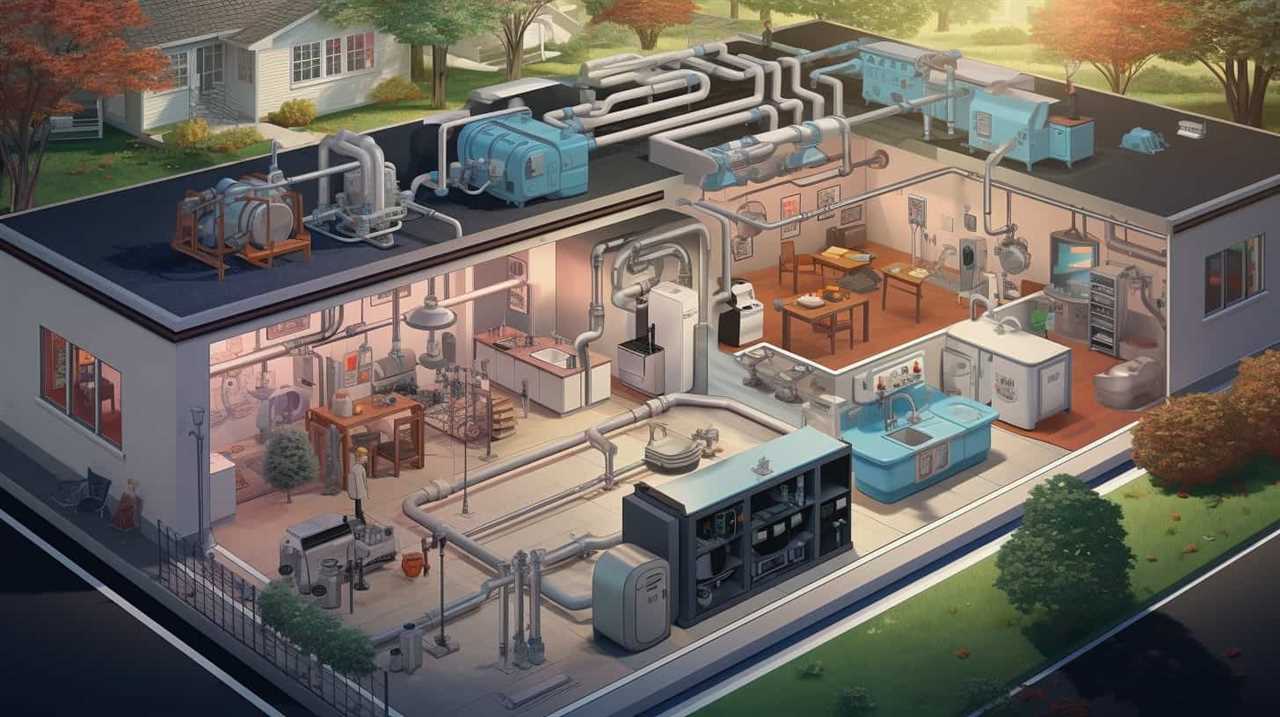
-
Maintaining energy efficiency: A well-maintained heat pump operates more efficiently, which can lead to lower energy bills and reduced environmental impact.
-
Ensuring optimal performance: Regular maintenance ensures that your heat pump is performing at its best, providing consistent heating and cooling throughout your home.
By prioritizing regular maintenance, we can prevent breakdowns, increase the lifespan of our heat pumps, and ensure they operate at their highest efficiency.
Let’s now delve into the importance of regular heat pump maintenance.
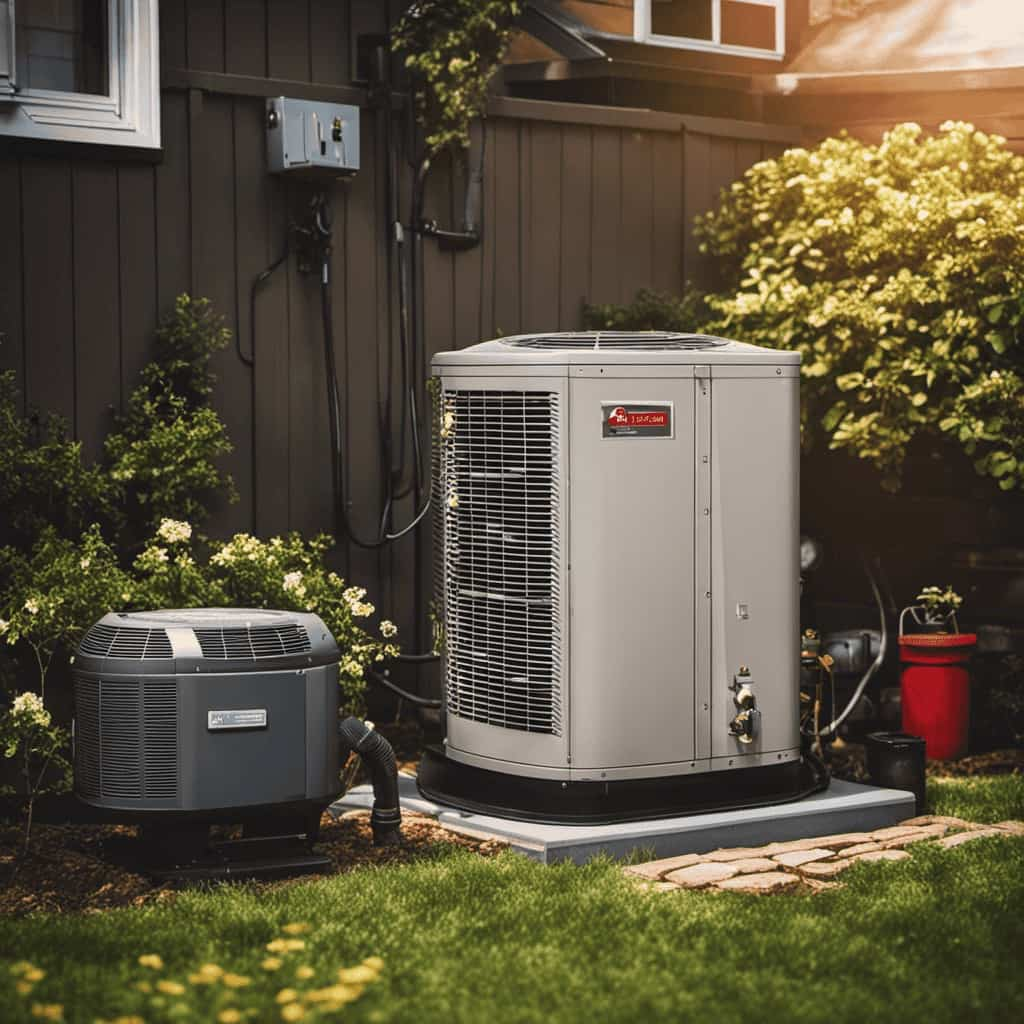
Importance of Regular Heat Pump Maintenance
Regular heat pump maintenance is essential for optimal performance and efficiency. By preventing system malfunctions, we can avoid costly repairs and ensure that our heat pump operates smoothly throughout the year.
Additionally, regular maintenance helps maximize energy savings and extends the lifespan of the equipment, making it a smart investment for eco-home owners.
Preventing System Malfunctions
We should prioritize routine heat pump maintenance to prevent potential system malfunctions. Regular maintenance not only ensures the longevity of your heat pump but also helps optimize its performance. Here are some essential tips for preventing system breakdowns and troubleshooting common issues:
- Clean or replace air filters regularly to maintain proper airflow and prevent dust buildup.
- Check and clean the outdoor unit to remove any debris or obstructions that could hinder its operation.
- Inspect and clean the evaporator and condenser coils to improve heat transfer efficiency.
- Check the refrigerant levels and ensure they’re within the manufacturer’s recommended range.
Maximizing Energy Savings
By properly maintaining our heat pump, we can significantly increase energy savings and reduce our environmental impact. Regular maintenance ensures that our heat pump operates at peak efficiency, maximizing insulation effectiveness and incorporating passive cooling techniques.
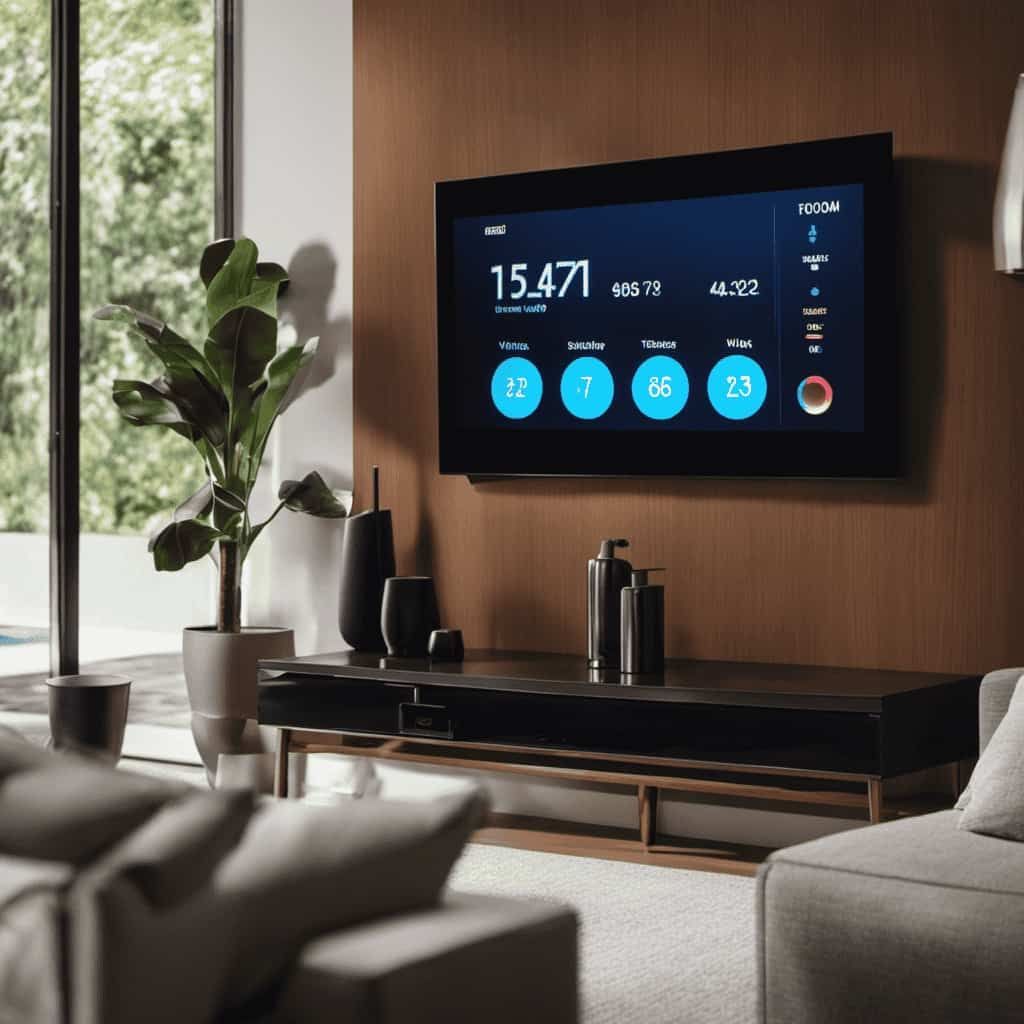
Here are some key maintenance tasks to consider:
-
Clean or replace air filters: Dirty filters restrict airflow and make the heat pump work harder, increasing energy consumption.
-
Inspect and clean outdoor unit: Remove debris, leaves, and dirt from the outdoor unit to maintain proper airflow.
-
Check refrigerant levels: Low refrigerant levels can reduce the heat pump’s efficiency. Consult a professional to check and refill if necessary.
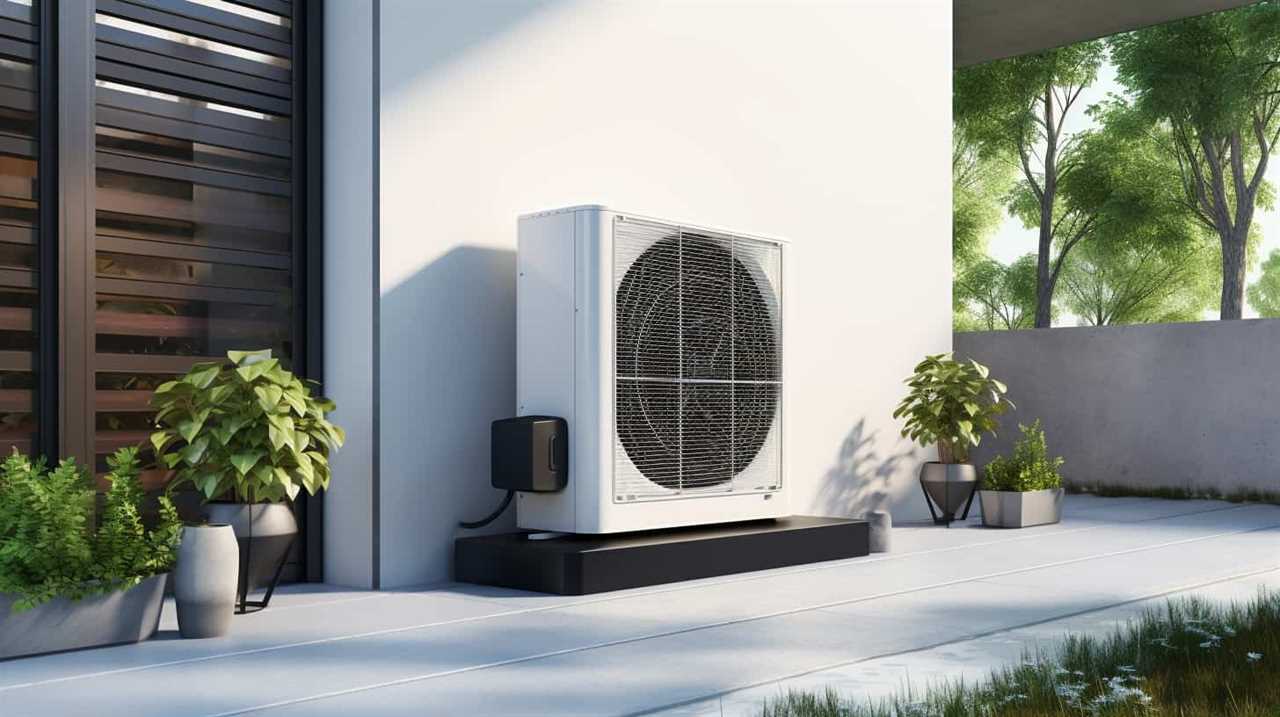
-
Schedule professional maintenance: Regular tune-ups by a qualified technician can identify and fix any issues, ensuring optimal performance.
Implementing these maintenance practices will help us save energy, reduce our carbon footprint, and prolong the lifespan of our heat pump.
Extending Equipment Lifespan
With proper heat pump maintenance, we can extend the lifespan of our equipment, ensuring optimal performance and energy efficiency. Regular maintenance plays a crucial role in maximizing efficiency and increasing equipment longevity. Here are some key reasons why regular heat pump maintenance is essential:
- Prevents breakdowns and costly repairs
- Improves energy efficiency, reducing utility bills
- Enhances indoor air quality by keeping the system clean
- Maintains warranty coverage and protects your investment
By scheduling regular maintenance appointments with a qualified technician, you can identify and address any potential issues before they become major problems. This proactive approach not only saves you money but also extends the lifespan of your heat pump, allowing it to operate at its full potential for years to come.

Now, let’s delve into the next topic: optimizing heat pump performance with insulation.
Optimizing Heat Pump Performance With Insulation
Insulating your home is crucial for maximizing heat pump performance. By using high-quality insulating materials, you can prevent heat loss and ensure that your heat pump operates efficiently.
Insulation acts as a barrier, reducing the amount of heat that escapes from your home in the winter and enters in the summer. This means that your heat pump doesn’t have to work as hard to maintain a comfortable temperature, resulting in lower energy consumption and reduced utility bills.
When insulating your home, pay attention to areas prone to heat loss, such as windows, doors, walls, and the attic. By properly insulating these areas, you can create a well-sealed and energy-efficient environment that optimizes the performance of your heat pump.

Smart Thermostats for Heat Pump Efficiency
We can enhance the efficiency of our heat pump by using smart thermostats. Here are some smart thermostat features that can help optimize heat pump efficiency:
-
Remote temperature control: With a smart thermostat, you can adjust the temperature of your home from anywhere using your smartphone. This allows you to turn off the heat pump when you’re not at home and turn it on before you return, ensuring energy isn’t wasted.
-
Learning capabilities: Smart thermostats can learn your schedule and adjust the temperature accordingly. They can also adapt to your preferences over time, saving energy by avoiding unnecessary heating or cooling.
-
Energy usage monitoring: Many smart thermostats provide real-time energy usage data, allowing you to track and analyze your energy consumption. This information can help you make informed decisions to further improve efficiency.
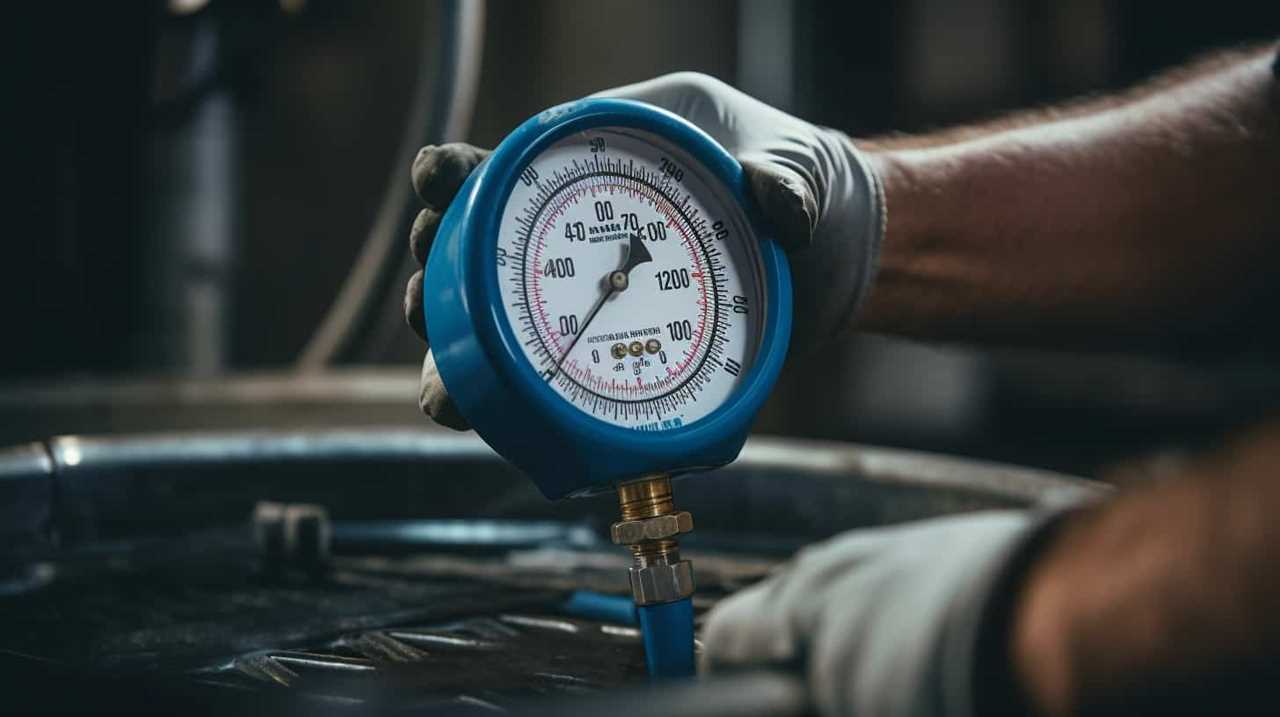
-
Integration with other smart devices: Smart thermostats can be connected to other smart home devices, such as occupancy sensors or weather stations, to optimize energy usage based on occupancy and weather conditions.
Using Programmable Timers to Maximize Heat Pump Efficiency
To maximize heat pump efficiency, we can utilize programmable timers in our eco-homes. Programmable timers are a valuable tool that allows us to schedule and control the operation of our heat pumps, optimizing energy usage and reducing costs.
By setting specific temperature levels for different times of the day, we can ensure that our homes are comfortably heated when needed, while also minimizing energy consumption during periods of low occupancy or when we’re asleep.
This not only helps us save money on our energy bills but also reduces our carbon footprint. Programmable timers are a key component of energy-saving strategies in eco-homes, providing us with the convenience and control to maximize the efficiency of our heat pumps and create a more sustainable living environment.
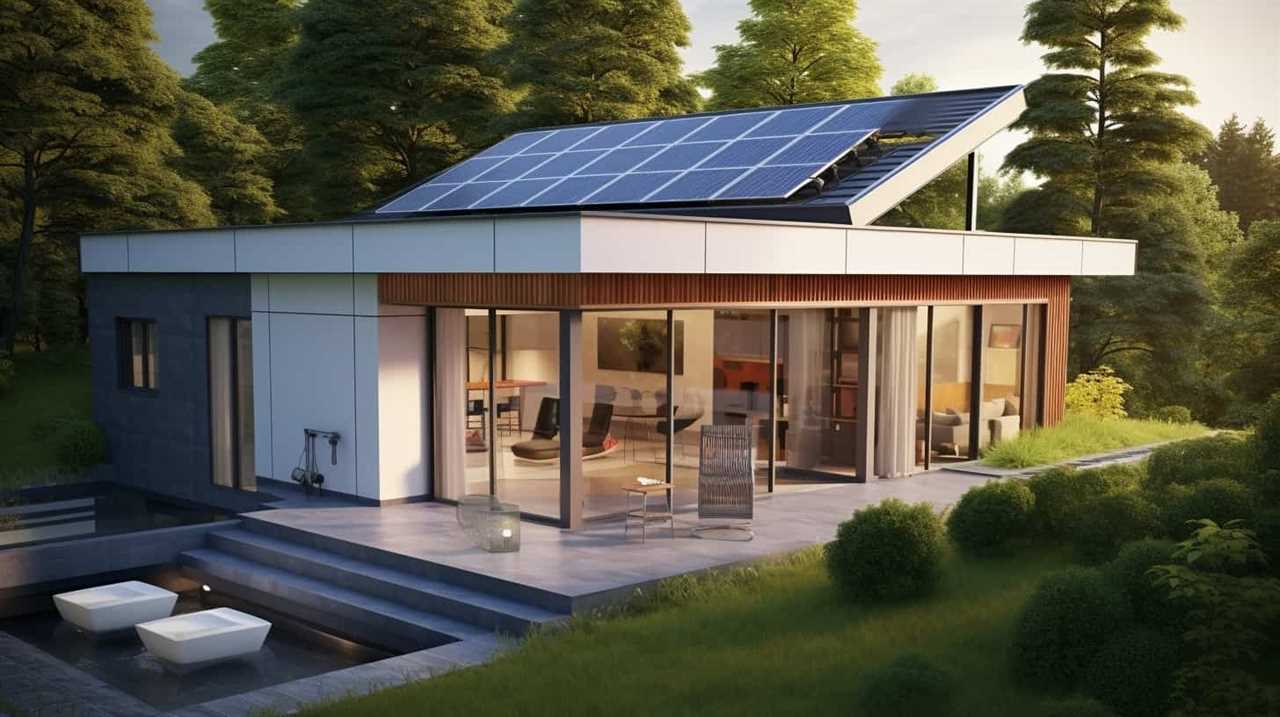
Setting the Right Temperature for Energy Savings
When it comes to maximizing energy efficiency in our eco-homes, setting the right temperature is crucial.
By finding the optimal temperature settings for our heat pumps, we can ensure that we aren’t wasting energy or money.
It’s important to strike a balance between comfort and energy savings, and by following some simple guidelines, we can achieve both.
Optimal Temperature Settings
For optimal energy savings, set your heat pump temperature at an appropriate level. Proper temperature control is crucial in maximizing energy efficiency and reducing your carbon footprint. Here are some practical tips to help you set the right temperature for energy savings:
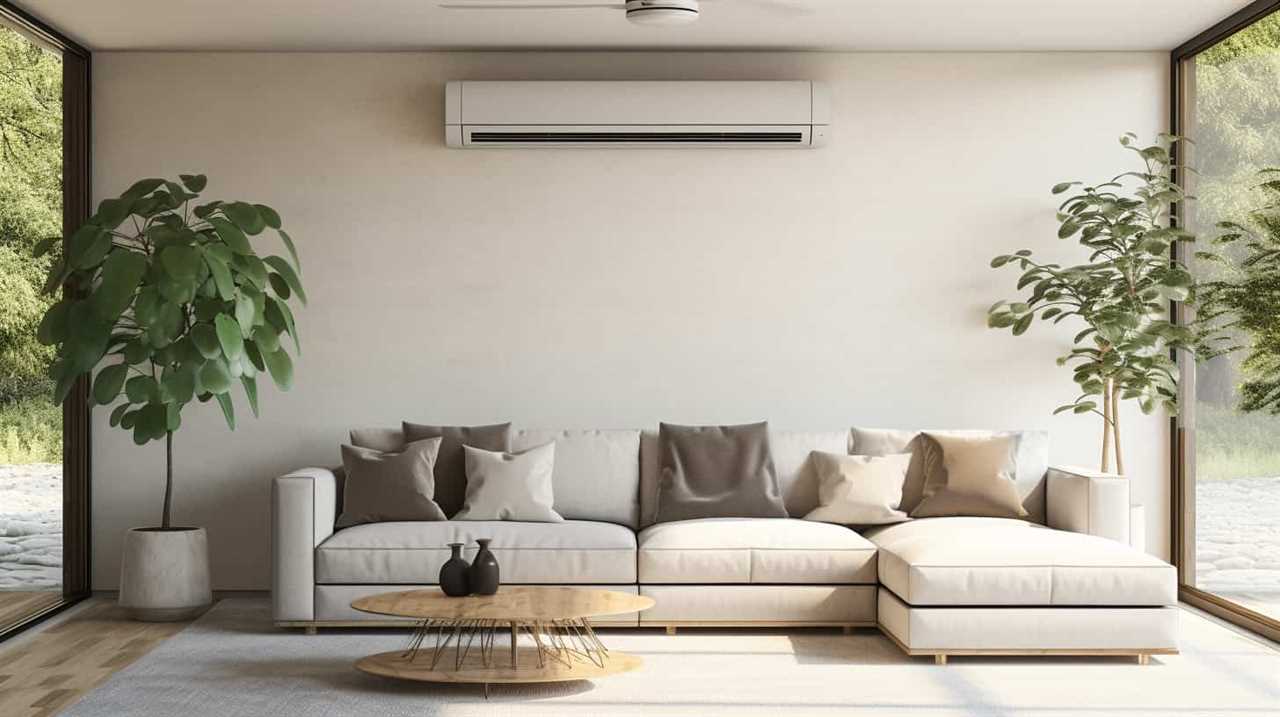
-
Find the sweet spot: Experiment with different temperature settings to find the most comfortable yet energy-efficient level for your home.
-
Utilize programmable thermostats: Take advantage of programmable thermostats to automatically adjust the temperature when you’re not at home or during sleeping hours.
-
Embrace layering: Instead of cranking up the heat, layer your clothing and use blankets to stay warm during cooler months.
-
Maintain consistent temperatures: Avoid drastic temperature fluctuations and strive for a consistent indoor climate to minimize energy consumption.

By implementing these strategies, you can optimize your heat pump’s efficiency and reduce energy waste.
Now, let’s move on to maximizing energy efficiency in other areas of your eco-home.
Maximizing Energy Efficiency
Our goal is to maximize energy efficiency in our eco-home by setting the right temperature for energy savings.
One important factor in achieving this is maximizing insulation effectiveness. Ensuring that our home is well-insulated helps to minimize heat loss in the winter and heat gain in the summer. This reduces the workload on our heat pump, leading to lower energy consumption.
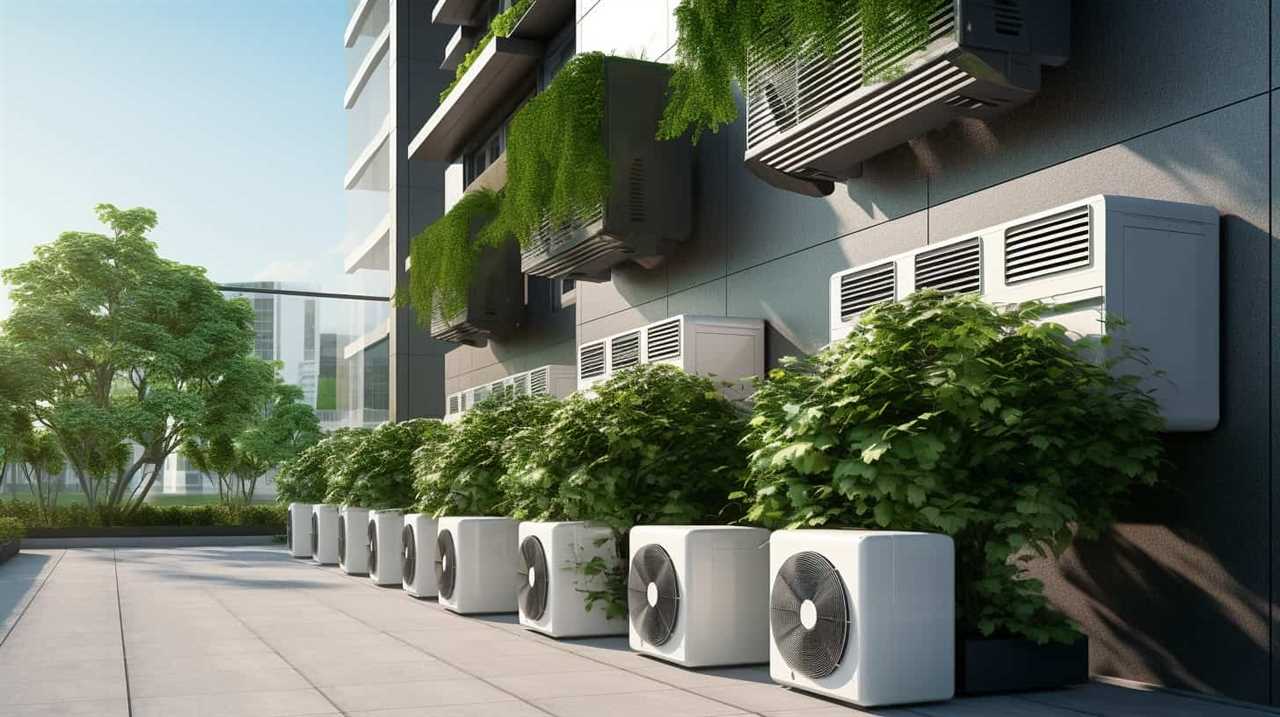
Additionally, optimizing airflow direction can further enhance energy efficiency. By keeping air vents clear and unobstructed, we can ensure that the conditioned air circulates effectively throughout our home. This helps to maintain a consistent temperature and reduces the need for the heat pump to work harder.
With these strategies, we can make the most of our heat pump’s energy-saving capabilities and create a more eco-friendly living environment.
Airflow Optimization for Enhanced Heat Pump Efficiency
We can maximize the efficiency of our heat pump by optimizing airflow. Proper airflow management and fan speed control are essential for enhancing the performance of our heat pump system.
Here are some practical tips to optimize airflow and improve heat pump efficiency:

- Clean the air filters regularly to ensure unrestricted airflow.
- Keep the outdoor unit free from debris and vegetation to allow proper airflow.
- Consider using a variable-speed fan to adjust the airflow according to the heating or cooling needs.
- Ensure that the supply and return vents aren’t blocked or obstructed to maintain proper airflow circulation.
Utilizing Geothermal Heat Pump Systems for Renewable Energy
When it comes to renewable energy in eco-homes, geothermal heat pump systems are an excellent option to consider. These systems utilize the constant temperature of the earth to provide heating and cooling, making them highly efficient and environmentally friendly.
The benefits of geothermal heat pumps include reduced energy consumption, lower utility bills, and a smaller carbon footprint, making them a smart choice for homeowners looking to maximize their energy efficiency.
Geothermal Heat Pump Benefits
By utilizing geothermal heat pump systems for renewable energy, homeowners can benefit from increased energy efficiency and reduced carbon emissions. Geothermal heat pumps offer several advantages, such as:
- Lower operating costs: Geothermal heat pumps can save homeowners up to 70% on heating and cooling costs compared to traditional HVAC systems.
- Long lifespan: Geothermal heat pumps have a lifespan of 20-25 years, which is significantly longer than conventional systems.
- Minimal maintenance: These systems require minimal maintenance, leading to lower maintenance costs over time.
- Environmental friendliness: Geothermal heat pumps use renewable energy from the earth’s heat, reducing dependence on fossil fuels and lowering carbon emissions.
Although the initial cost of geothermal heat pump installation can be higher than traditional systems, the long-term savings and environmental benefits make it a worthwhile investment for eco-conscious homeowners.

Renewable Energy Advantages
Geothermal heat pump systems offer renewable energy advantages, such as increased energy efficiency and reduced carbon emissions. These systems harness the heat from the earth’s core, providing a constant and reliable source of energy for heating and cooling purposes. By utilizing geothermal heat pump systems, homeowners can significantly reduce their carbon footprint and contribute to a more sustainable future.
Table: Renewable Energy Advantages of Geothermal Heat Pump Systems
| Advantages | Benefits |
|---|---|
| Increased Energy Efficiency | Geothermal heat pumps are up to 400% more efficient than traditional heating and cooling systems. |
| Reduced Carbon Emissions | By relying on renewable energy, geothermal systems produce significantly fewer greenhouse gas emissions. |
| Cost-Effective Solutions | While the initial installation costs may be higher, geothermal heat pump systems offer long-term savings on energy bills. |
| Reliable and Low Maintenance | Geothermal systems have fewer moving parts, resulting in reduced maintenance requirements and increased reliability. |
Utilizing geothermal heat pump systems not only provides a cost-effective solution for homeowners but also contributes to a greener and more sustainable future by reducing carbon emissions. With increased energy efficiency and low maintenance requirements, these systems offer an ideal renewable energy option for eco-homes.
Efficiency of Heat Pumps
We often overlook the efficiency of heat pumps when utilizing geothermal heat pump systems for renewable energy in our eco-homes. However, understanding heat pump technology and energy efficiency ratings for heat pumps is crucial for maximizing their performance and reducing energy consumption.
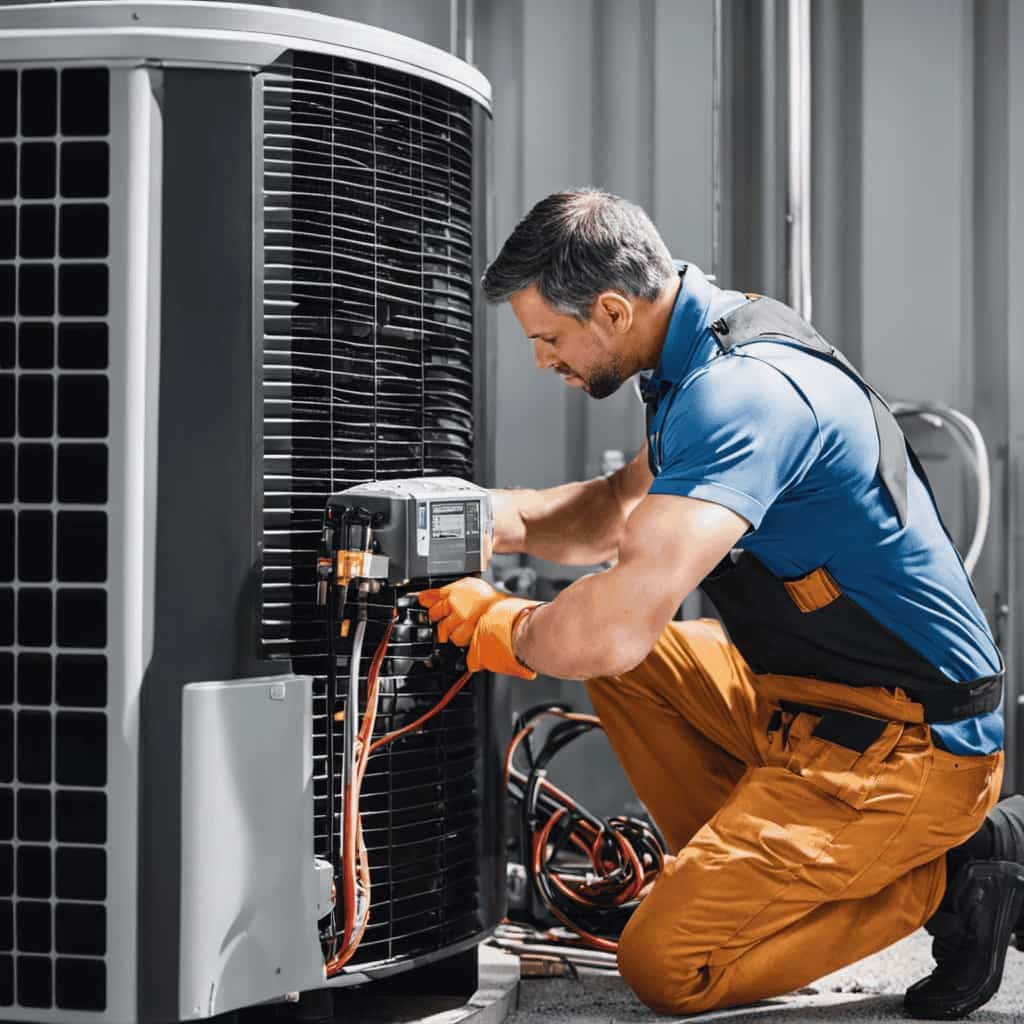
Here are some key points to keep in mind:
-
Proper sizing: Ensuring that the heat pump is correctly sized for your home is essential for optimal efficiency.
-
Seasonal performance: Look for heat pumps with high seasonal energy efficiency ratio (SEER) and heating seasonal performance factor (HSPF) ratings to ensure efficient operation throughout the year.
-
Regular maintenance: Regularly servicing and maintaining your heat pump will help improve its efficiency and prolong its lifespan.
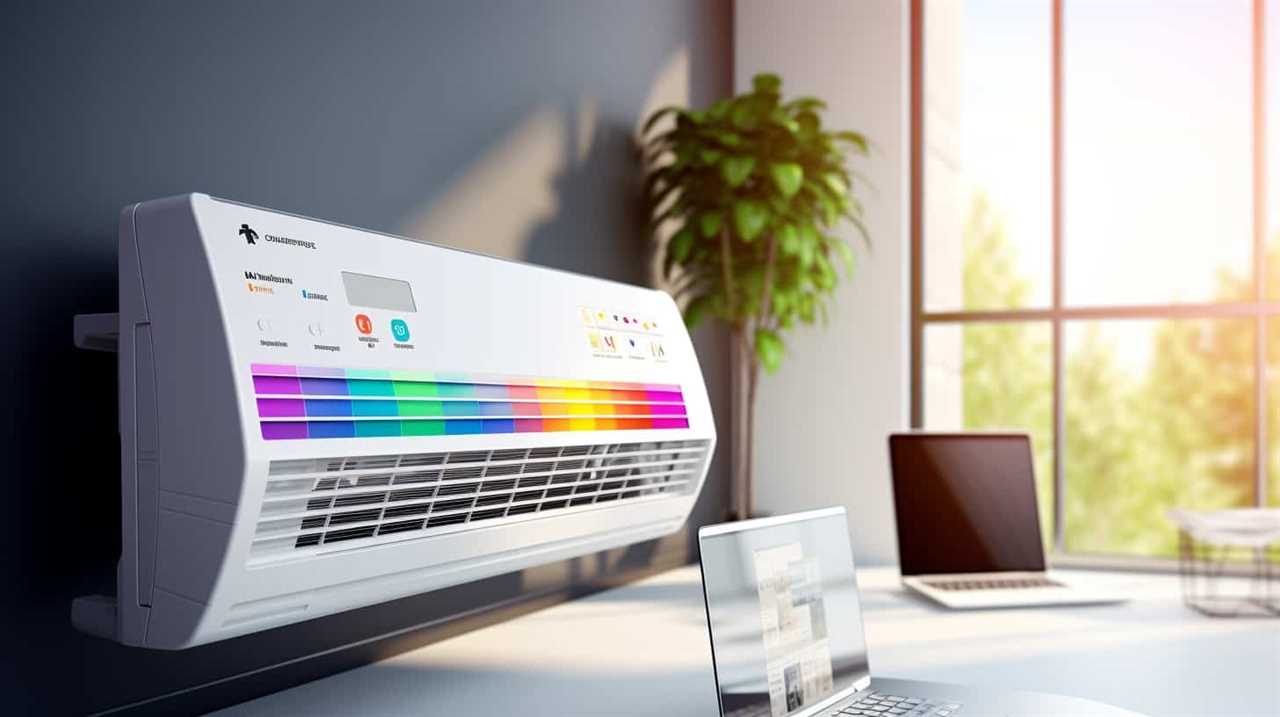
-
Energy monitoring: Using energy monitoring tools can help you track the energy consumption of your heat pump and identify areas for improvement.
Solar Panels to Power Your Heat Pump
Installing multiple solar panels can significantly boost the efficiency of our heat pump system. By harnessing the power of the sun, solar panels provide a renewable and clean source of energy to power our heat pumps.
When considering solar panel installation, it’s important to take advantage of government incentives that may be available. These incentives can help offset the cost of installation and make it more affordable for homeowners.
Additionally, solar panels can generate excess electricity, which can be stored or sold back to the grid, further maximizing their efficiency.

Weatherproofing Your Eco-Home for Improved Heat Pump Efficiency
Let’s make sure our eco-home is properly weatherproofed to maximize the efficiency of our heat pump. Weatherproofing techniques and insulation methods can significantly reduce heat loss and improve the overall performance of our heat pump system. Here are some effective strategies to consider:
-
Seal air leaks: Identify and seal any gaps, cracks, or openings in windows, doors, and walls to prevent cold drafts and heat loss.
-
Insulate walls and ceilings: Proper insulation helps to maintain a consistent indoor temperature and reduces the workload on the heat pump.
-
Install double-glazed windows: Double-glazed windows provide better insulation and minimize heat transfer between the inside and outside of the house.

-
Use weatherstripping: Apply weatherstripping around windows and doors to create a tight seal and prevent air leakage.
Heat Pump Efficiency in Different Climate Zones
Heat pump efficiency can vary in different climate zones, so it’s important to consider the specific needs and requirements of each region. When it comes to heat pump maintenance, there are some energy-saving tips that can help optimize efficiency in different climates.
In colder climates, it’s important to insulate the outdoor unit and check for any ice build-up. This will ensure that the heat pump can operate efficiently even in freezing temperatures.
In hotter climates, shading the outdoor unit can help prevent it from overheating and reduce the workload on the system. Regularly cleaning or replacing the air filters is also crucial for maintaining efficiency in any climate.
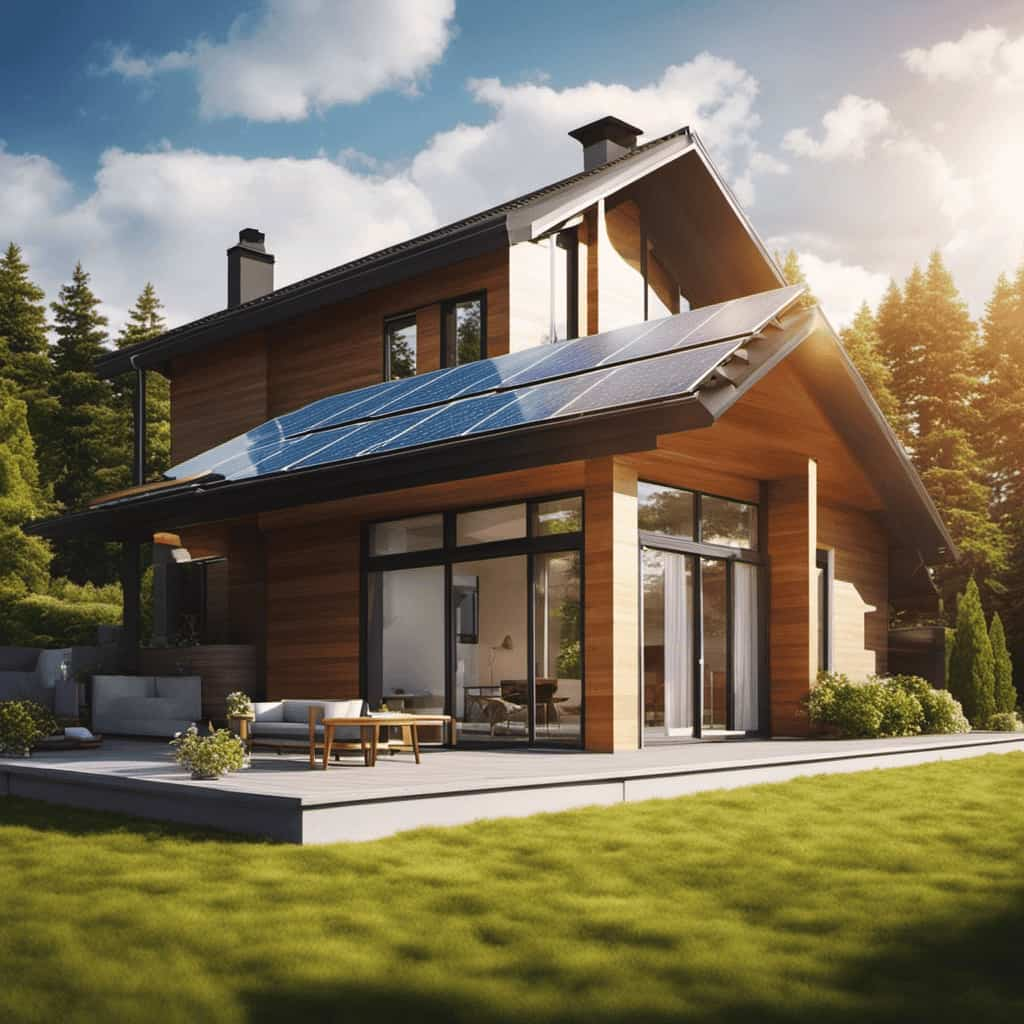
By following these maintenance tips, you can ensure that your heat pump operates at its highest efficiency level, regardless of the climate zone you’re in.
Now let’s move on to the next section about monitoring and tracking energy usage for heat pump efficiency.
Monitoring and Tracking Energy Usage for Heat Pump Efficiency
To optimize heat pump efficiency, we can start by regularly monitoring and tracking our energy usage. By keeping a close eye on our energy consumption, we can make informed decisions on how to improve the performance of our heat pump system.
Here are some practical tips for tracking energy costs and analyzing heat pump performance:

- Install a smart energy monitor to track real-time energy usage and identify areas of high consumption.
- Keep a record of energy bills and compare them month-to-month to identify any sudden increases in energy usage.
- Utilize energy tracking apps or software to analyze energy consumption patterns and identify opportunities for energy-saving adjustments.
- Conduct regular maintenance checks to ensure that the heat pump system is operating at peak efficiency.
Frequently Asked Questions
Can I Install a Heat Pump in My Existing Home, or Does It Only Work for New Eco-Homes?
Yes, you can install a heat pump in your existing home. The heat pump installation process may involve some modifications, but it is possible. However, keep in mind the cost of installing a heat pump in an existing home.
How Long Does It Take to Install a Heat Pump in an Eco-Home?
Installing a heat pump in an eco-home is a quick and efficient process. With our expert team, we can have it up and running in no time, saving you money on installation costs and maximizing the benefits of eco-friendly heating.
Are There Any Government Incentives or Tax Credits Available for Installing a Heat Pump in an Eco-Home?
Yes, there are government incentives and tax credits available for installing a heat pump in an eco-home. These incentives and credits can help offset the cost and make it more affordable for homeowners.
How Often Should I Schedule Maintenance for My Heat Pump to Ensure Optimal Efficiency?
To ensure optimal efficiency, we recommend scheduling regular maintenance for your heat pump. This simple step can help identify any issues early on and keep your system running smoothly. Don’t forget to check out our energy-saving tips!

Can I Use a Heat Pump as the Sole Source of Heating and Cooling in My Eco-Home, or Do I Need a Backup System?
We need a backup system for our eco-home if we rely solely on a heat pump for heating and cooling. While heat pumps are effective, having a backup ensures comfort in case of any issues.
Conclusion
In conclusion, maximizing heat pump efficiency is crucial for eco-home owners.
By understanding how heat pumps work, choosing the right size, and ensuring proper installation and maintenance, you can optimize their performance.
Incorporating insulation, solar panels, and weatherproofing techniques further enhance efficiency.
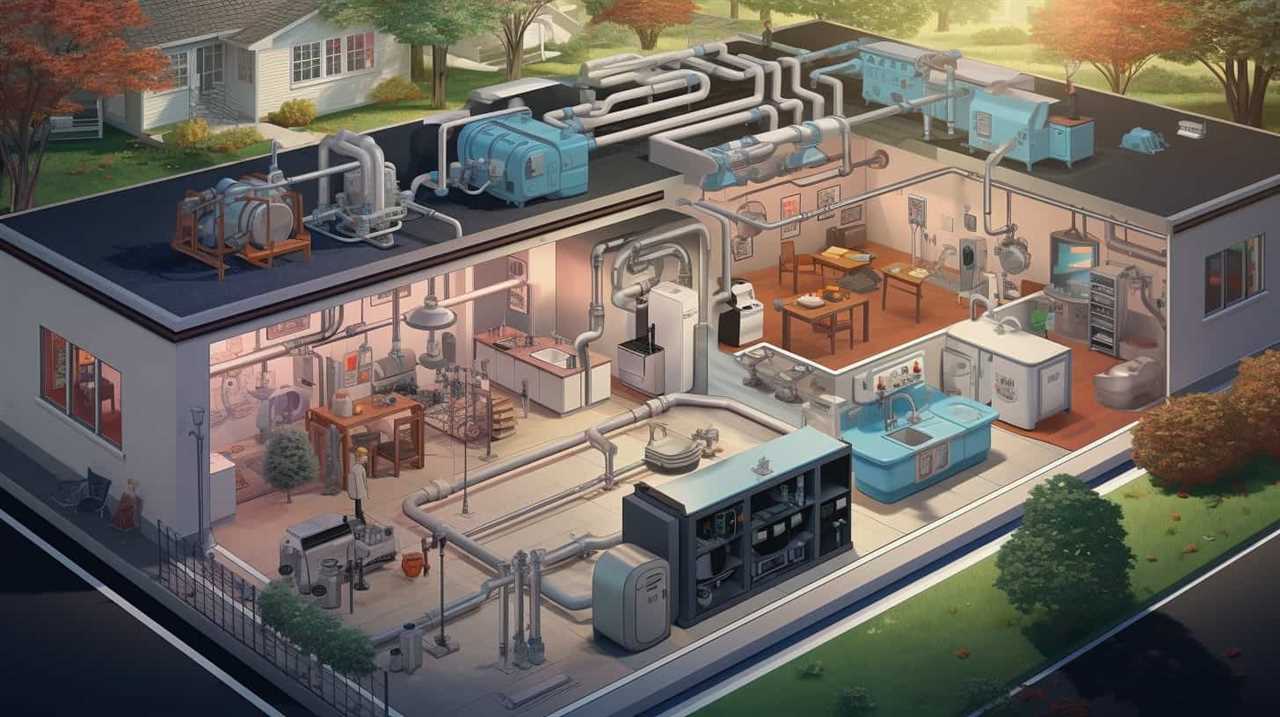
It’s important to consider climate zones and monitor energy usage for continuous improvement.
Think of your heat pump as the heart of your eco-home, pumping warmth and sustainability throughout.
Keep it healthy and efficient for a truly harmonious living environment.
Energy Efficiency
Top Energy-Efficient Heat Pump Models Reviewed


We have completed the research and identified the best energy-efficient heat pump models for you.
Get ready to save on your energy bills and keep your home comfortable all year round.
In this article, we’ll be reviewing the Rheem RP20, Lennox XP25, Carrier Infinity 20, Trane XV20i, and Daikin Quaternity heat pumps.
These models are packed with advanced features and cutting-edge technology.
So, sit back, relax, and let us guide you through the world of energy-efficient heat pumps.
Key Takeaways
- The Rheem RP20, Lennox XP25, Carrier Infinity 20, and Trane XV20i are among the top energy-efficient heat pump models available.
- These models feature advanced technologies such as intelligent eye technology, 4-way airflow system, and advanced filtration system, which contribute to energy savings and improved indoor air quality.
- The Daikin Quaternity heat pump stands out for its high SEER rating, superior performance, and ability to handle extreme weather conditions.
- In addition to their innovative features, these heat pump models offer competitive pricing, long-term cost savings, and warranty coverage, making them an excellent choice for energy-efficient heating and cooling.
Rheem RP20 Heat Pump
The Rheem RP20 Heat Pump stands out as an energy-efficient option due to its exceptional performance and range of features. It offers advanced technology and innovative design, ensuring optimal comfort while minimizing energy consumption. The heat pump features a variable-speed motor that adjusts its speed according to the heating or cooling needs of the home, resulting in reduced energy usage and lower utility bills. Additionally, it is equipped with a two-stage compressor, allowing for more precise temperature control and enhanced efficiency. Overall, the Rheem RP20 Heat Pump is a reliable and energy-efficient solution that provides exceptional performance and comfort for any home.
Lennox XP25 Heat Pump
We found the Lennox XP25 Heat Pump to be an excellent choice for energy efficiency due to its innovative features and advanced technology.
Here are some key points that make the Lennox XP25 Heat Pump stand out:

- Variable-capacity operation allows for precise temperature control and reduced energy consumption.
- The XP25 is ENERGY STAR® certified, ensuring high energy efficiency and cost savings.
- It features a SilentComfort™ technology that minimizes noise levels for a quieter operation.
- The unit is equipped with a SunSource® Solar-Ready option, allowing you to harness the power of the sun for even greater energy savings.
- The XP25 comes with the iComfort® S30 smart thermostat, which provides precise temperature control and advanced programming capabilities.
With its cutting-edge technology and energy-efficient design, the Lennox XP25 Heat Pump offers a reliable and cost-effective solution for maintaining a comfortable home environment while reducing energy consumption.
Now, let’s move on to the next heat pump model: the Carrier Infinity 20 Heat Pump.
Carrier Infinity 20 Heat Pump
Now let’s take a look at the Carrier Infinity 20 Heat Pump, which offers exceptional energy efficiency and advanced features. The Carrier Infinity 20 heat pump is known for its impressive energy-saving capabilities and innovative technologies. It is designed to provide optimal comfort while reducing energy consumption.
Here is a table highlighting the pros and cons of the Carrier Infinity 20 heat pump:

| Pros | Cons |
|---|---|
| Excellent energy efficiency | Higher upfront cost |
| Quiet operation | Requires professional installation |
| Advanced features for enhanced comfort | Limited availability of parts |
The Carrier Infinity 20 heat pump incorporates several energy-saving features, including variable-speed technology, which allows the unit to adjust its output based on the heating or cooling demands, resulting in lower energy consumption. Additionally, it utilizes a two-stage compressor, which helps maintain consistent temperatures and reduces energy usage.
In the next section, we will discuss the Trane XV20i heat pump and its energy-efficient features.
Trane XV20i Heat Pump
Let’s dive into the features of the Trane XV20i Heat Pump, known for its energy efficiency and innovative technology. Here is an analysis of its efficiency and a cost comparison:
Efficiency Analysis:

- The Trane XV20i boasts a SEER (Seasonal Energy Efficiency Ratio) rating of up to 22, making it highly efficient in both heating and cooling modes.
- It also has a HSPF (Heating Seasonal Performance Factor) of up to 10, ensuring efficient heat production during colder months.
- With its variable-speed compressor, the XV20i adjusts its output based on the current temperature and demand, optimizing energy usage.
- The unit’s ComfortLink™ II communicating technology allows for precise control and coordination with other HVAC components, further enhancing efficiency.
- The TruComfort™ technology ensures consistent and even temperatures throughout the home, reducing energy wastage.
Cost Comparison:
- While the initial cost of the Trane XV20i may be higher than some other models, its energy efficiency can lead to significant long-term savings on utility bills.
- The variable-speed compressor and precise control capabilities enable the XV20i to operate at lower speeds for longer durations, resulting in reduced energy consumption.
Transitioning into the subsequent section about the ‘daikin quaternity heat pump’, another top energy-efficient model worth exploring is…
Daikin Quaternity Heat Pump
Moving on to the Daikin Quaternity Heat Pump, let’s explore its features and energy efficiency.
The Daikin Quaternity is a highly efficient heat pump model that offers a wide range of benefits. It comes equipped with advanced features such as intelligent eye technology, which detects human presence and adjusts the temperature accordingly to save energy. The Quaternity also boasts a unique 4-way airflow system that ensures even distribution of warm or cool air throughout the room.

In terms of energy efficiency, the Quaternity has a high SEER rating of up to 20.6, making it one of the most efficient heat pumps on the market. When compared to other Daikin heat pump models, the Quaternity stands out for its superior performance and innovative features.
As for pricing, the Daikin Quaternity is competitively priced, offering excellent value for money.
Frequently Asked Questions
What Is the Average Lifespan of These Heat Pump Models?
On average, the lifespan of these heat pump models is around 15-20 years. However, it is important to note that proper maintenance is crucial to ensure the longevity of the unit. Regular servicing and cleaning can significantly extend its lifespan.
Do These Heat Pump Models Come With a Warranty?
Yes, these heat pump models come with a warranty. We understand that warranty coverage is important to guarantee customer satisfaction. Rest assured, our reviewed models offer reliable warranties to protect your investment.

Are These Heat Pump Models Eligible for Any Energy Efficiency Rebates or Incentives?
Yes, these heat pump models are eligible for energy efficiency rebates and incentives. They offer significant energy savings compared to traditional heating methods, making them a cost-effective and environmentally-friendly choice.
Can These Heat Pump Models Be Used in Both Residential and Commercial Settings?
Yes, these heat pump models can be used in both residential and commercial settings. When considering cost, it’s important to note that residential applications typically have lower energy demands compared to commercial settings.
Are These Heat Pump Models Compatible With Smart Home Technology?
Yes, these heat pump models are compatible with smart home technology. They offer seamless smart home integration, allowing users to control and monitor their energy-saving features remotely, providing convenience and efficiency for both residential and commercial settings.
Conclusion
After reviewing the top energy-efficient heat pump models, it’s clear that each of them offers impressive performance and cost savings.

However, one statistic that stands out is the Rheem RP20 Heat Pump’s Seasonal Energy Efficiency Ratio (SEER) rating of up to 20.5. This means it’s highly efficient in cooling and heating, helping homeowners save on energy bills.
Overall, these models provide excellent options for those looking to improve their home’s energy efficiency.
Energy Efficiency
Boost Your Heat Pump Energy Efficiency Effortlessly

Let’s crank up the efficiency of our heat pumps with minimal effort!
In this article, we’ll explore simple yet effective ways to enhance the energy efficiency of your heat pump.
From understanding efficiency ratings to optimizing placement and size, we’ll cover it all.
We’ll also dive into the importance of regular maintenance, smart thermostat technology, and alternative heating methods.

Get ready to maximize your heat pump’s performance effortlessly.
Key Takeaways
- Understanding heat pump efficiency ratings: SEER rating measures cooling efficiency, HSPF rating measures heating efficiency, higher SEER and HSPF ratings indicate better efficiency and greater energy savings.
- Implementing proper heat pump sizing and placement: Proper insulation reduces heat loss, well-insulated homes require smaller heat pumps, consider noise levels and airflow when placing the heat pump, install it away from direct sunlight and heat sources for improved performance and energy efficiency.
- Regular maintenance and cleaning for optimal performance: Clean or replace air filters every 1-3 months, check and clean the outdoor unit twice a year, schedule professional maintenance annually, remove debris and obstructions around the outdoor unit, dust and vacuum the indoor unit regularly.
- Utilizing smart thermostat technology: Smart thermostats optimize energy efficiency by adjusting the temperature based on heating preferences, allowing for temperature scheduling and remote control, offering energy-saving modes and real-time energy usage data, maximizing efficiency and reducing energy costs effortlessly.
Understanding Heat Pump Efficiency Ratings
As we delve into the topic of understanding heat pump efficiency ratings, it’s important to grasp the significance of these ratings in maximizing energy savings. Heat pump SEER (Seasonal Energy Efficiency Ratio) ratings and HSPF (Heating Seasonal Performance Factor) ratings play a crucial role in determining the efficiency of a heat pump.
The SEER rating measures the cooling efficiency of the heat pump, while the HSPF rating measures its heating efficiency. A higher SEER rating indicates better cooling efficiency, while a higher HSPF rating indicates better heating efficiency. Understanding these ratings helps us make informed decisions when choosing a heat pump, as a higher rating means greater energy savings.
By considering both SEER and HSPF ratings, we can ensure that our heat pump operates efficiently throughout the year.
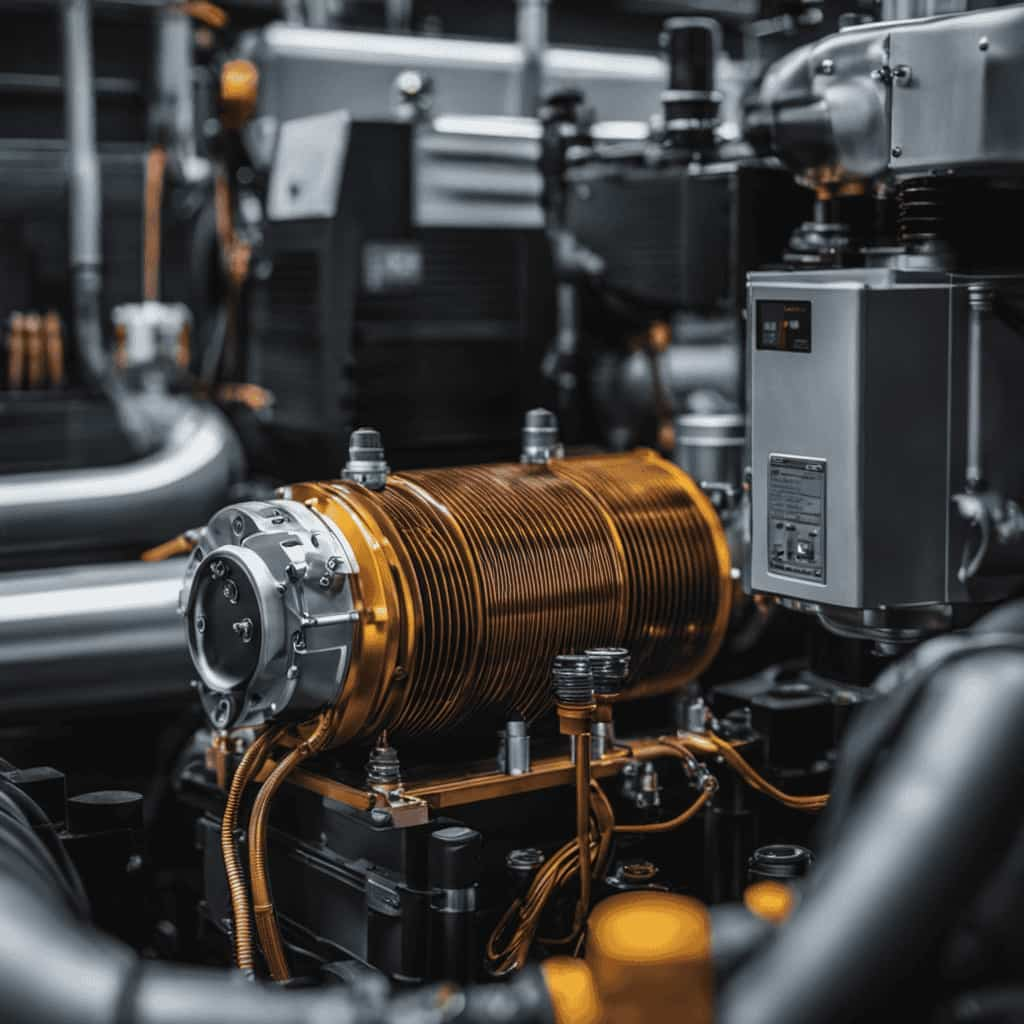
Now, let’s explore how implementing proper heat pump sizing and placement further enhances energy efficiency.
Implementing Proper Heat Pump Sizing and Placement
To ensure optimal energy efficiency, we must carefully determine the correct size and placement of our heat pump. Proper insulation is key to reducing heat loss and ensuring that the heat pump operates efficiently. A well-insulated home will require a smaller heat pump, saving both energy and money.
When it comes to placement, it’s important to consider factors such as noise levels and airflow. The heat pump should be installed in a location that allows for proper air circulation and easy access for maintenance. Additionally, placing the heat pump away from direct sunlight and sources of heat can help prevent overheating and improve its performance.
Regular Maintenance and Cleaning for Optimal Performance
We should regularly maintain and clean our heat pump to ensure optimal performance. By following a maintenance checklist and utilizing effective cleaning techniques, we can prolong the lifespan of our heat pump and maximize its energy efficiency.

Here is a simple maintenance checklist to keep in mind:
| Task | Frequency |
|---|---|
| Clean or replace air filters | Every 1-3 months |
| Check and clean outdoor unit | Twice a year, in spring and fall |
| Schedule professional maintenance | Annually |
In addition to regular maintenance, proper cleaning techniques are essential. Here are some tips:
- Clean the outdoor unit: Remove any debris or leaves around the unit and keep it clear of obstructions to promote proper airflow.
- Clean the indoor unit: Dust and vacuum the indoor unit regularly to prevent dirt buildup that can hinder performance.
- Clean the coils: Use a soft brush or cloth to gently clean the coils, removing any dirt or debris.
Regular maintenance and cleaning will ensure that your heat pump operates at its best. In the next section, we will explore the benefits of utilizing smart thermostat technology.
Utilizing Smart Thermostat Technology
By integrating smart thermostat technology into our heating system, we can optimize energy efficiency and effortlessly control our heat pump.

Smart thermostats provide advanced features that help improve energy consumption and optimize temperature control. These devices can learn our heating preferences and adjust the temperature accordingly, ensuring that our heat pump operates at its most efficient level.
With the ability to program temperature schedules and remotely control the thermostat through smartphone apps, we can easily regulate our heat pump’s operation even when we’re not at home.
Additionally, smart thermostats offer energy-saving modes and provide real-time energy usage data, allowing us to make informed decisions about our energy consumption.
With the use of smart thermostat technology, we can maximize our heat pump’s efficiency and reduce our energy costs effortlessly.

Supplementing Heat Pump Usage With Alternative Heating Methods
Using a few alternative heating methods in conjunction with our heat pump can significantly improve its energy efficiency. Here are some options to consider:
-
Geothermal Heating Benefits:
-
Harness the stable temperature of the earth to provide consistent and efficient heating.
-
Reduce electricity consumption by up to 70% compared to traditional heating systems.

-
Enjoy long-term cost savings and lower carbon emissions.
-
Solar Panel Integration:
-
Install solar panels to generate renewable energy for both heating and electricity needs.
-
Reduce reliance on the grid and lower utility bills.

-
Take advantage of government incentives and tax credits for solar installations.
Frequently Asked Questions
Can I Increase the Energy Efficiency of My Heat Pump by Using Renewable Energy Sources?
Yes, we can increase the energy efficiency of our heat pump by using renewable energy sources. Incorporating solar or geothermal power can reduce reliance on traditional energy and maximize efficiency.
What Are Some Common Mistakes to Avoid When Sizing and Placing a Heat Pump?
When it comes to sizing and placing a heat pump, it’s important to avoid common mistakes. By following best practices, you can ensure optimal efficiency and performance for your heat pump.
Is It Necessary to Hire a Professional for Regular Maintenance and Cleaning of My Heat Pump?
Regular heat pump maintenance by professionals ensures optimal performance and longevity. However, cost-effective DIY cleaning can also be beneficial. It’s important to keep filters clean, check for leaks, and ensure proper airflow for maximum energy efficiency.

How Can a Smart Thermostat Help Improve the Energy Efficiency of My Heat Pump?
A smart thermostat can improve the energy efficiency of our heat pump by utilizing features like programmable schedules and remote control. Integrating our heat pump with a smart thermostat maximizes comfort and reduces energy waste.
Are There Any Government Incentives or Rebates Available for Using Alternative Heating Methods Alongside a Heat Pump?
Yes, there are government incentives and rebates available for using alternative heating methods alongside a heat pump. These incentives encourage the use of renewable energy sources and can help lower your energy costs.
Conclusion
In conclusion, by understanding heat pump efficiency ratings, properly sizing and placing the unit, performing regular maintenance and cleaning, and utilizing smart thermostat technology, you can effortlessly boost your heat pump’s energy efficiency.
Additionally, considering alternative heating methods can further supplement the usage of your heat pump.

By implementing these strategies, you can save energy and maximize the performance of your heat pump, ultimately leading to a more cost-effective and eco-friendly heating solution.
Energy Efficiency
Understanding the Economics of High-Efficiency Heat Pumps

We have exclusive information about the economics of high-efficiency heat pumps. Prepare to analyze the cost-benefit ratio, assess the return on investment, and discover government incentives.
Our article will break down the factors affecting the economic viability of these innovative systems. Whether you’re a homeowner or a business owner, understanding the numbers behind high-efficiency heat pumps is crucial for making informed decisions.
So, let’s crunch some numbers and uncover the economic advantages of these energy-saving powerhouses.
Key Takeaways
- Conducting an economic analysis is crucial for informed decision-making.
- High-efficiency heat pumps offer significant long-term savings.
- Energy savings and reduced environmental impact contribute to a positive return on investment.
- Government incentives and financing options improve economic viability.
The Importance of Economic Analysis in High-Efficiency Heat Pump Installation
We believe that when considering high-efficiency heat pump installation, it’s crucial to conduct an economic analysis.

Economic considerations play a pivotal role in determining the long-term savings and overall cost-effectiveness of such installations.
By conducting a thorough economic analysis, one can assess the upfront costs, operational expenses, and potential savings associated with high-efficiency heat pumps.
This analysis allows for an informed decision-making process, ensuring that the chosen heat pump system aligns with the desired outcomes and budgetary constraints.
Evaluating the economic viability of high-efficiency heat pump installation involves considering factors such as energy efficiency ratings, maintenance costs, and potential utility rebates or incentives.

Additionally, the analysis should assess the projected lifespan of the heat pump system to determine the long-term savings and return on investment.
Understanding the Cost-Benefit Ratio of High-Efficiency Heat Pumps
Our analysis of the cost-benefit ratio shows that high-efficiency heat pumps offer significant long-term savings and a favorable return on investment.
When considering the cost effectiveness of high-efficiency heat pumps, it’s important to look beyond the initial upfront costs. While high-efficiency heat pumps may have a higher initial investment compared to traditional heating systems, the energy savings they provide over time more than make up for this difference.
These heat pumps are designed to operate with maximum efficiency, utilizing advanced technology to minimize energy consumption. This results in lower monthly utility bills, leading to substantial savings over the lifespan of the heat pump.

Additionally, the reduced energy usage helps to decrease the environmental impact, making high-efficiency heat pumps an innovative and sustainable choice for heating and cooling needs.
Factors Affecting the Economic Viability of High-Efficiency Heat Pump Systems
Factors such as energy prices, installation costs, and government incentives play a crucial role in determining the economic viability of high-efficiency heat pump systems.
Energy consumption is a key consideration when evaluating the economic feasibility of these systems. High-efficiency heat pumps are designed to minimize energy usage by efficiently transferring heat from one place to another. By reducing energy consumption, homeowners can significantly lower their utility bills, making the investment in a high-efficiency heat pump system more financially attractive.
Additionally, the environmental impact of high-efficiency heat pumps must be taken into account. These systems produce fewer greenhouse gas emissions compared to traditional heating systems, contributing to a greener and more sustainable future.

Evaluating the return on investment for high-efficiency heat pump installation requires careful consideration of these factors. With lower energy consumption and reduced environmental impact, high-efficiency heat pumps offer a promising solution for both cost savings and environmental stewardship.
Evaluating the Return on Investment for High-Efficiency Heat Pump Installation
When evaluating the return on investment for high-efficiency heat pump installation, it’s important to consider various factors such as energy savings, installation costs, and potential government incentives.
High-efficiency heat pumps offer significant energy savings compared to traditional heating systems. By efficiently transferring heat from the air or ground, these pumps can reduce energy consumption and lower utility bills. Additionally, high-efficiency heat pumps provide long-term benefits by reducing greenhouse gas emissions and promoting sustainability.
While the initial installation costs may be higher than conventional systems, the energy savings over time can offset this expense. Moreover, government incentives such as tax credits or rebates can further enhance the return on investment.

In the following section, we’ll explore government incentives and financing options for high-efficiency heat pumps, which can further improve the economic viability of these systems.
Exploring Government Incentives and Financing Options for High-Efficiency Heat Pumps
To further enhance the economic viability of high-efficiency heat pumps, we’ll now explore government incentives and financing options available. These incentives and financing options can significantly reduce the upfront costs of installing a high-efficiency heat pump system, making it more accessible and affordable for homeowners and businesses alike.
Here are five options to consider:
-
Government grants: Many governments offer grants or financial assistance programs to promote the adoption of energy-efficient technologies, including high-efficiency heat pumps. These grants can help offset the initial investment and encourage more people to switch to these energy-saving systems.

-
Tax credits: Some jurisdictions provide tax credits or deductions for the purchase and installation of high-efficiency heat pumps. These credits can help reduce the overall cost of the system and provide additional savings for the homeowner or business.
-
Low-interest loans: Financial institutions and government agencies often offer low-interest loans specifically for energy-efficient upgrades, including high-efficiency heat pumps. These loans provide favorable terms and repayment options, making it easier to finance the installation of these systems.
-
Energy efficiency programs: Many utility companies offer energy efficiency programs that provide incentives for customers to upgrade to high-efficiency heat pumps. These programs may include rebates, discounts, or other financial incentives to encourage the adoption of energy-saving technologies.
-
Power purchase agreements: In some cases, homeowners or businesses can enter into power purchase agreements with third-party providers. These agreements allow the customer to pay for the energy produced by the high-efficiency heat pump system, rather than the upfront cost of the equipment itself. This can provide a more affordable and flexible financing option.

Frequently Asked Questions
How Does the Efficiency of a High-Efficiency Heat Pump Compare to Traditional Heating Systems?
High-efficiency heat pumps outperform traditional heating systems in terms of efficiency and cost. By utilizing advanced technology, these pumps can achieve higher levels of efficiency, resulting in significant energy savings and lower utility bills.
Are There Any Maintenance or Repair Costs Associated With High-Efficiency Heat Pumps?
Maintenance and repair costs for high-efficiency heat pumps are important factors to consider. Regular maintenance can help prevent major issues, but occasional repair expenses may arise. These costs should be factored into the overall economics of the system.
Can High-Efficiency Heat Pumps Be Used in Both Residential and Commercial Buildings?
Yes, high-efficiency heat pumps can be used in both residential and commercial buildings. They offer energy-efficient heating and cooling solutions for various applications, making them a versatile choice for innovative and sustainable HVAC systems.
Are There Any Environmental Benefits to Using High-Efficiency Heat Pumps?
Using high-efficiency heat pumps has significant environmental benefits. They reduce greenhouse gas emissions and contribute to energy savings. These pumps are a sustainable and innovative solution for both residential and commercial buildings.

What Factors Should Be Considered When Choosing the Right Size High-Efficiency Heat Pump for a Specific Space?
When choosing the right size high-efficiency heat pump, several factors should be considered. These include the square footage of the space, insulation levels, climate conditions, and desired temperature settings.
Conclusion
In conclusion, understanding the economics of high-efficiency heat pumps is crucial for making informed decisions. By analyzing the cost-benefit ratio and evaluating factors such as installation costs, energy savings, and government incentives, we can determine the economic viability of these systems.
With their potential for significant return on investment and the availability of financing options, high-efficiency heat pumps offer a promising solution for efficient and cost-effective heating and cooling.
Embrace the power of these systems and unlock a world of economic benefits.

-

 Residential and Commercial Applications7 months ago
Residential and Commercial Applications7 months agoBest Amana Heat Pump Reviews
-

 Thermal Energy Transfer7 months ago
Thermal Energy Transfer7 months agoBreakthroughs in Modern Heat Pump Systems: Thermal Energy Edition
-

 Geothermal Heat Pumps6 months ago
Geothermal Heat Pumps6 months agoInnovative Geothermal Heat Pump Manufacturers Revolutionize Energy Efficiency
-

 Residential and Commercial Applications7 months ago
Residential and Commercial Applications7 months agoBest Heat Pump
-

 Geothermal Heat Pumps6 months ago
Geothermal Heat Pumps6 months agoUpgrade Your Comfort with Our Efficient HVAC Systems
-

 Air Conditioning5 months ago
Air Conditioning5 months agoExploring Energy-Efficient Air Conditioning Heat Pumps
-

 Energy Consumption4 months ago
Energy Consumption4 months ago10 Key Comparisons: Heat Pump Vs Traditional Heating
-

 Thermal Energy Transfer4 months ago
Thermal Energy Transfer4 months agoBoost Your Heat Pump Efficiency: Interactive Guide








